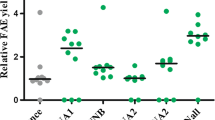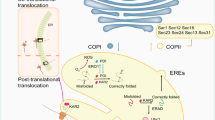Abstract
Pharmaceutical grade trypsin is in ever-increasing demand for medical and industrial applications. Improving the efficiency of existing biotechnological manufacturing processes is therefore paramount. When produced biotechnologically, trypsinogen—the inactive precursor of trypsin—is advantageous, since active trypsin would impair cell viability. To study factors affecting cell physiology and the production of trypsinogen in fed-batch cultures, we built a fusion protein of porcine trypsinogen and enhanced green fluorescent protein (EGFP) in Pichia pastoris. The experiments were performed with two different pH values (5.0 and 5.9) and two constant specific growth rates (0.02 and 0.04 1/h), maintained using exponential addition of methanol. All the productivity data presented rely on an active determination of trypsin obtained by proteolysis of the trypsinogen produced. The pH of the medium did not affect cell growth, but significantly influenced specific production of trypsinogen: A 1.7-fold higher concentration of trypsinogen was achieved at pH 5.9 (64 mg/L at 0.02 1/h) compared to pH 5.0. EGFP was primarily used to facilitate detection of intracellular protein over the biosynthetic time course. Using flow cytometry with fluorescence detection, cell disruption was avoided, and protein extraction and purification prior to analysis were unnecessary. However, Western blot and SDS-PAGE showed that cleavage of EGFP-trypsinogen fusion protein occurred, probably caused by Pichia-endogenous proteases. The fluorescence analysis did therefore not accurately represent the actual trypsinogen concentration. However, we gained new experimentally-relevant insights, which can be used to avoid misinterpretation of tracking and quantifying as well as online-monitoring of proteins with the frequently used fluorescent tags.







Similar content being viewed by others
Abbreviations
- AOX1 :
-
Alcohol oxidase 1
- CDW:
-
Cell dry weight
- EGFP:
-
Enhanced greed fluorescent protein
References
Ahmad M, Hirz M, Pichler H, Schwab H (2014) Protein expression in Pichia pastoris: recent achievements and perspectives for heterologous protein production. Appl Microbiol Biotechnol 98:5301–5317. https://doi.org/10.1007/s00253-014-5732-5
Anasontzis GE, Pena MS, Spadiut O et al (2014) Effects of temperature and glycerol and methanol-feeding profiles on the production of recombinant galactose oxidase in Pichia pastoris. Biotechnol Prog 30:728–735. https://doi.org/10.1002/btpr.1878
Broger T, Odermatt RP, Ledergerber P, Sonnleitner B (2009) Exploiting fluorescent reporter molecules for process analytical technology (PAT). Chim Int J Chem 63:171–173. https://doi.org/10.2533/chimia.2009.171
Guerrero-Olazaran M, Escamilla-Trevino LL, Castillo-Galvan M et al (2009) Recombinant shrimp (Litopenaeus vannamei) trypsinogen production in Pichia pastoris. Biotechnol Prog 25:1310–1316. https://doi.org/10.1002/btpr.197
Gurramkonda C, Adnan A, Gabel T et al (2009) Simple high-cell density fed-batch technique for high-level recombinant protein production with Pichia pastoris: application to intracellular production of hepatitis B surface antigen. Microb Cell Factories 8:8. https://doi.org/10.1186/1475-2859-8-13
Hanquier J, Sorlet Y, Desplancq D, Baroche L, Ebtinger M, Lefevre JF, Pattus F, Hershberger CL, Vertes AA (2003) A single mutation in the activation site of bovine trypsinogen enhances its accumulation in the fermentation broth of the yeast Pichia pastoris. Appl Environ Microbiol 69:1108–1113
Hohenblum H, Borth N, Mattanovich D (2003) Assessing viability and cell-associated product of recombinant protein producing Pichia pastoris with flow cytometry. J Biotechnol 102:281–290
Hyka P, Zullig T, Ruth C, Looser V, Meier C, Klein J, Melzoch K, Meyer HP, Glieder A, Kovar K (2010) Combined use of fluorescent dyes and flow cytometry to quantify the physiological state of Pichia pastoris during the production of heterologous proteins in high-cell-density fed-batch cultures. Appl Environ Microbiol 76:4486–4496. https://doi.org/10.1128/AEM.02475-09
Jungo C, Marison I, von Stockar U (2007) Mixed feeds of glycerol and methanol can improve the performance of Pichia pastoris cultures: a quantitative study based on concentration gradients in transient continuous cultures. J Biotechnol 128:824–837. https://doi.org/10.1016/j.jbiotec.2006.12.024
Juturu V, Wu JC (2018) Heterologous protein expression in Pichia pastoris: latest research progress and applications. ChemBioChem 19:7–21
Kunitz M, Northrop JH (1934) Inactivation of crystalline trypsin. J Gen Physiol 17:591–615
Li Z, Leung W, Yon A, Nguyen J, Perez VC, Vu J, Giang W, Luong LT, Phan T, Salazar KA, Gomez SR, Au C, Xiang F, Thomas DW, Franz AH, Lin-Cereghino J, Lin-Cereghino GP (2010) Secretion and proteolysis of heterologous proteins fused to the Escherichia coli maltose binding protein in Pichia pastoris. Protein Expr Purif 72:113–124. https://doi.org/10.1016/j.pep.2010.03.004
Ling Z, Kang Z, Liu Y, Liu S, Chen J, du G (2014) Improvement of catalytic efficiency and thermostability of recombinant Streptomyces griseus trypsin by introducing artificial peptide. World J Microbiol Biotechnol 30:1819–1827. https://doi.org/10.1007/s11274-014-1608-1
Ling ZM, Ma TB, Li JH, du G, Kang Z, Chen J (2012) Functional expression of trypsin from Streptomyces griseus by Pichia pastoris. J Ind Microbiol Biotechnol 39:1651–1662. https://doi.org/10.1007/s10295-012-1172-3
Looser V, Bruhlmann B, Bumbak F, Stenger C, Costa M, Camattari A, Fotiadis D, Kovar K (2015) Cultivation strategies to enhance productivity of Pichia pastoris: a review. Biotechnol Adv 33:1177–1193. https://doi.org/10.1016/j.biotechadv.2015.05.008
Macouzet M, Simpson BK, Lee BH (2005) Expression of a cold-adapted fish trypsin in Pichia pastoris. FEMS Yeast Res 5:851–857. https://doi.org/10.1016/j.femsyr.2005.02.007
Paulova L, Hyka P, Branska B et al (2012) Use of a mixture of glucose and methanol as substrates for the production of recombinant trypsinogen in continuous cultures with Pichia pastoris Mut+. J Biotechnol 157:180–188. https://doi.org/10.1016/j.jbiotec.2011.10.010
Potgieter TI, Kersey SD, Mallem MR, Nylen AC, d'Anjou M (2010) Antibody expression kinetics in glycoengineered Pichia pastoris. Biotechnol Bioeng 106:918–927. https://doi.org/10.1002/bit.22756
Potvin G, Ahmad A, Zhang ZS (2012) Bioprocess engineering aspects of heterologous protein production in Pichia pastoris: a review. Biochem Eng J 64:91–105. https://doi.org/10.1016/j.bej.2010.07.017
Ren HT, Yuan JQ (2005) Model-based specific growth rate control for Pichia pastoris to improve recombinant protein production. J Chem Technol Biotechnol 80:1268–1272. https://doi.org/10.1002/jctb.1321
Rockwell NC, Krysan DJ, Komiyama T, Fuller RS (2002) Precursor processing by Kex2/furin proteases. Chem Rev 102:4525–4548. https://doi.org/10.1021/cr010168i
Saborowski R, Sahling G, Navarette Del Toro MA et al (2004) Stability and effects of organic solvents on endopeptidases from the gastric fluid of the marine crab Cancer pagurus. J Mol Catal B Enzym 30:109–118. https://doi.org/10.1016/j.molcatb.2004.04.002
Shu M, Shen W, Wang XJ, Wang F, Ma L, Zhai C (2015) Expression, activation and characterization of porcine trypsin in Pichia pastoris GS115. Protein Expr Purif 114:149–155. https://doi.org/10.1016/j.pep.2015.06.014
Siepert EM, Gartz E, Tur MK, Delbrück H, Barth S, Büchs J (2012) Short-chain fluorescent tryptophan tags for on-line detection of functional recombinant proteins. BMC Biotechnol 12:65. https://doi.org/10.1186/1472-6750-12-65
Sinha J, Plantz BA, Inan M, Meagher MM (2005) Causes of proteolytic degradation of secreted recombinant proteins produced in methylotrophic yeast Pichia pastoris: case study with recombinant ovine interferon-tau. Biotechnol Bioeng 89:102–112. https://doi.org/10.1002/bit.20318
Sinha J, Plantz BA, Zhang W, Gouthro M, Schlegel V, Liu CP, Meagher MM (2003) Improved production of recombinant ovine interferon-tau by mut(+) strain of Pichia pastoris using an optimized methanol feed profile. Biotechnol Prog 19:794–802. https://doi.org/10.1021/bp025744q
Sjöblom M, Lindberg L, Holgersson J, Rova U (2012) Secretion and expression dynamics of a GFP-tagged mucin-type fusion protein in high cell density Pichia pastoris bioreactor cultivations. Adv Biosci Biotechnol 3:238–248. https://doi.org/10.4236/abb.2012.33033
Snapp E (2005) Design and Use of Fluorescent Fusion Proteins in Cell Biology. Curr Protoc Cell Biol. https://doi.org/10.1002/0471143030.cb2104s27
Surribas A, Resina D, Ferrer P, Valero F (2007) Rivoflavin may interfere with on-line monitoring of secreted green fluorescence protein fusion proteins in Pichia pastoris. Microb Cell Factories 6:15. https://doi.org/10.1186/1475-2859-6-15
Surribas A, Resina D, Ferrer P, Valero F (2006) Limitations using GFP as a protein expression reporter in Pichia pastoris. Microb Cell Factories 5:P56. https://doi.org/10.1186/1475-2859-5-s1-p56
Tang JB, Zhu P, Yang HM, Sun LM, Song SL, Ji AG (2008) Expression and secretion of recombinant ZZ-EGFP fusion protein by the methylotrophic yeast Pichia pastoris. Biotechnol Lett 30:1409–1414. https://doi.org/10.1007/s10529-008-9714-5
Titani K, Sasagawa T, Woodbury RG, Ericsson LH, Dorsam H, Kraemer M, Neurath H, Zwilling R (1983) Amino acid sequence of crayfish (Astacus fluviatilis) trypsin If. Biochemistry 22:1459–1465. https://doi.org/10.1021/bi00275a021
Viader-Salvado JM, Fuentes-Garibay JA, Castillo-Galvan M et al (2013) Shrimp (Litopenaeus vannamei) trypsinogen production in Pichia pastoris bioreactor cultures. Biotechnol Prog 29:11–16. https://doi.org/10.1002/btpr.1646
Walsh KA, Kauffman DL, Kumar KSVS, Neurath H (1964) On the structure and function of bovine trypsinogen and trypsin. Proc Natl Acad Sci U S A 51:301–308
Whiting DR, Guariguata L, Weil C, Shaw J (2011) IDF diabetes atlas: global estimates of the prevalence of diabetes for 2011 and 2030. Diabetes Res Clin Pract 94:311–321. https://doi.org/10.1016/j.diabres.2011.10.029
Wu Z, Jiang G, Xiang P, Xu H (2008) Anionic trypsin from North Pacific krill (Euphausia pacifica): purification and characterization. Int J Pept Res Ther 14:113–120. https://doi.org/10.1007/s10989-007-9119-7
Yamada Y, Maeda K, Mikata K (1994) The phylogenetic relationships of the hat-shaped ascospore-forming, nitrate-assimilating Pichia species, formerly classified in the genus Hansenula Sydow et Sydow, based on the partial sequences of 18S and 26S ribosomal RNAs (Saccharomycetaceae): the proposals of three new genera, Ogataea, Kuraishia, and Nakazawaea. Biosci Biotechnol Biochem 58:1245–1257. https://doi.org/10.1271/bbb.58.1245
Yamada Y, Matsuda M, Maeda K, Mikata K (1995) The phylogenetic relationships of methanol-assimilating yeasts based on the partial sequences of 18S and 26S ribosomal RNAs: the proposal of Komagataella gen. nov. (Saccharomycetaceae). Biosci Biotechnol Biochem 59:439–444. https://doi.org/10.1271/bbb.59.439
Yang Z, Zhang Z (2017) Engineering strategies for enhanced production of protein and bio-products in Pichia pastoris: a review. Biotechnol Adv 36(1):182–195
Yu XH, Zhai C, Zhong X, Tang W, Wang X, Yang H, Chen W, Ma L (2015) High-level expression and characterization of carboxypeptidase Y from Saccharomyces cerevisiae in Pichia pastoris GS115. Biotechnol Lett 37:161–167. https://doi.org/10.1007/s10529-014-1667-2
Zahrl RJ, Peña DA, Mattanovich D, Gasser B (2017) Systems biotechnology for protein production in Pichia pastoris. FEMS Yeast Res 17. https://doi.org/10.1093/femsyr/fox068
Zhang WH, Bevins MA, Plantz BA, Smith LA, Meagher MM (2000) Modeling Pichia pastoris growth on methanol and optimizing the production of a recombinant protein, the heavy-chain fragment C of botulinum neurotoxin, serotype A. Biotechnol Bioeng 70:1–8. https://doi.org/10.1002/1097-0290(20001005)70:1<1::aid-bit1>3.0.co;2-y
Zhang Y, Huang H, Yao X, du G, Chen J, Kang Z (2018) High-yield secretory production of stable, active trypsin through engineering of the N-terminal peptide and self-degradation sites in Pichia pastoris. Bioresour Technol 247:81–87. https://doi.org/10.1016/j.biortech.2017.08.006
Zhang Y, Liu R, Wu X (2007) The proteolytic systems and heterologous proteins degradation in the methylotrophic yeast Pichia pastoris. Ann Microbiol 57:553–560
Acknowledgements
This work was supported by the project MSM6046137305 and built on research performed within the Czech-Swiss project with the participation of Lonza AG and Lonza Biotec s.r.o. E!3415 Optytech, 1P05OE189 of Ministry of Education, Youth and Sports of the Czech Republic and the KTI-Project 7403.3;3 LSPP-LS (https://www.aramis.admin.ch/Grunddaten/?ProjectID=21894). The authors thank Zdeněk Voburka for the N-terminal sequencing analysis, Iwo Zamora for help with data analysis, Katrin Hecht for critical reading of the manuscript, and John Brooker and Maggi Lussi Bell for English proofreading.
Author information
Authors and Affiliations
Corresponding author
Rights and permissions
About this article
Cite this article
Raschmanová, H., Paulová, L., Branská, B. et al. Production and cleavage of a fusion protein of porcine trypsinogen and enhanced green fluorescent protein (EGFP) in Pichia pastoris. Folia Microbiol 63, 773–787 (2018). https://doi.org/10.1007/s12223-018-0619-y
Received:
Accepted:
Published:
Issue Date:
DOI: https://doi.org/10.1007/s12223-018-0619-y




